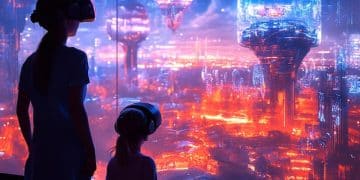The evolution of dramatic storytelling: a comprehensive review

The landscape of dramatic storytelling is undergoing a profound transformation, driven by technological innovations, shifting audience expectations, and an increasing appetite for complex narratives that reflect contemporary global dynamics.
Exploring the ever-changing world of dramatic storytelling offers a fascinating perspective on how narratives engage and resonate with audiences across different eras. From classic theater to modern streaming series, the evolution of drama reflects societal shifts, technological advancements, and a continuous push to explore the human condition with new perspectives.
The enduring appeal of drama: a historical perspective
Dramatic storytelling has been a cornerstone of human culture for millennia. Dating back to ancient Greek tragedies and comedies, the power of performance to evoke emotion, challenge conventions, and reflect societal norms has remained unparalleled. These early forms set fundamental archetypes and narrative structures that continue to influence contemporary works, demonstrating the timeless nature of compelling human conflict and resolution.
The Greek playwrights like Aeschylus, Sophocles, and Euripides laid the groundwork for narrative development, character arcs, and thematic exploration. Their plays often dealt with moral dilemmas, the clash between individual will and fate, and the consequences of hubris. This strong foundation provided a blueprint for future dramatic traditions, from Roman adaptations to Renaissance revivals.
From classical Greece to Shakespearean brilliance
The transition from classical antiquity to the vibrant theatrical scene of the Renaissance marks a significant evolution. William Shakespeare, often lauded as the greatest English playwright, redefined dramatic storytelling by infusing it with unparalleled linguistic artistry, psychological depth, and complex characterizations. His tragedies, comedies, and histories explored universal themes that continue to resonate with audiences worldwide.
- Aeschylus: Pioneer of dialogue and dramatic conflict.
- Sophocles: Master of character development and tragic irony.
- Euripides: Focused on realism and psychological complexity.
- Shakespeare: Elevated language, intricate plots, and profound human insights.
The Elizabethan era saw a boom in public theaters, making dramatic performances accessible to a broader audience. This period also refined the concept of genre, solidifying elements that would define drama for centuries. The enduring appeal of Shakespeare’s work lies in its timeless exploration of ambition, love, revenge, and redemption, themes that transcend cultural and historical boundaries.
This historical trajectory underscores that while the medium and tools of dramatic storytelling evolve, the core human desire to experience and understand narratives of conflict, emotion, and transformation remains constant. Understanding this lineage helps contextualize modern dramatic works and appreciate their roots in centuries of artistic tradition.
Technological innovations shaping modern drama
The 20th and 21st centuries have witnessed an explosion of technological innovations that have profoundly reshaped dramatic storytelling. From the advent of cinema to the rise of streaming platforms, each new technology has introduced novel ways to craft and disseminate narratives, fundamentally altering how audiences engage with dramatic content. These advancements haven’t just changed how stories are told; they’ve expanded the very possibilities of what a story can be.
The dawn of cinema and television
The invention of cinema at the turn of the 20th century introduced motion pictures, adding visual dynamism and scale previously impossible in live theater. Early filmmakers experimented with camera angles, editing, and special effects, transforming static plays into cinematic experiences. This new medium allowed for epic narratives, vast landscapes, and intimate close-ups, bringing characters and their emotions closer to the audience.
- Camera techniques: Panning, zooming, and tracking shots added narrative depth.
- Editing: Montage and cuts created new rhythms and conveyed information efficiently.
- Sound: Synchronized sound in the late 1920s brought dialogue and music to life.
Following motion pictures, the widespread adoption of television in the mid-20th century democratized dramatic storytelling even further. Television brought narratives directly into homes, evolving from live broadcasts to serialized dramas. This format allowed for character development over longer periods and fostered a deeper connection between audiences and ongoing stories. The episodic nature of TV also nurtured a new form of viewer loyalty, laying the groundwork for binge-watching culture.
The streaming revolution and interactive narratives
The most recent and perhaps most disruptive innovation is the rise of digital streaming platforms. Services like Netflix, Hulu, and Amazon Prime Video have revolutionized content consumption, offering on-demand access to a vast library of dramatic series and films. This shift has empowered audiences with unprecedented choice and control, leading to a golden age of television characterized by high production values and complex, multi-season narratives.
Beyond traditional viewing, technology is also paving the way for interactive dramatic experiences. Virtual reality (VR) and augmented reality (AR) are beginning to offer immersive storytelling where viewers can actively participate in the narrative, making choices that influence the plot. While still in its nascent stages, interactive drama promises to blur the lines between audience and storyteller, offering a truly personalized viewing experience. This frontier challenges traditional narrative structures, requiring creators to think about story multiple paths rather than a singular linear one.
These technological leaps continue to push the boundaries of dramatic storytelling, from cinematic spectacle to intimate screens and immersive virtual worlds. They not only expand the reach of narratives but also fundamentally alter the relationship between creator, story, and audience, promising an exciting future for the art form.
Shifting audience expectations and narrative complexity
Modern audiences approach dramatic storytelling with a sophisticated palate, shaped by decades of media exposure and an increasingly interconnected world. This shift in viewer expectations has driven creators to explore greater narrative complexity, moving beyond simple plotlines to embrace nuanced characters, ambiguous moralities, and intricate thematic explorations. The traditional clear-cut hero and villain archetypes are often replaced by characters existing in moral gray areas, reflecting a more complex understanding of human nature.
Beyond hero and villain: the anti-hero’s ascendancy
One of the most notable shifts in contemporary dramatic storytelling is the prominence of the anti-hero. Characters like Tony Soprano, Walter White, or Don Draper defy traditional notions of heroism, presenting protagonists who are deeply flawed, morally compromised, yet compelling. This embrace of ambiguity allows for richer character studies and provides audiences with a more realistic portrayal of internal and external conflicts.
The rise of the anti-hero reflects a societal discomfort with simplistic good-versus-evil narratives, preferring instead to examine the complexities of human morality. These characters force viewers to confront uncomfortable truths about themselves and the world, prompting deeper reflection on ethics, ambition, and the consequences of difficult choices. This trend also allows for more diverse storytelling, moving away from prescriptive character molds.
- Moral ambiguity: Characters exist in shades of gray rather than strict black and white.
- Psychological depth: Deeper exploration of character motivations and inner conflicts.
- Relatability: Flawed characters often feel more human and accessible.
This development is not merely a stylistic choice; it’s a profound shift in how stories grapple with themes of power, family, corruption, and personal redemption. It acknowledges that human beings are multifaceted, capable of both great good and great evil, often simultaneously. This makes for more challenging but ultimately more rewarding viewing experiences.
Interconnected narratives and long-form storytelling
Modern platforms, particularly streaming services, have enabled an unprecedented expansion of long-form dramatic storytelling. Series can now extend over multiple seasons, allowing for intricate plots, gradual character development, and the weaving of multiple storylines simultaneously. This extended canvas encourages creators to build complex narrative universes, with interconnected characters and overarching mythologies that unfold over hundreds of hours.
Audiences have grown accustomed to these sprawling narratives, meticulously dissecting every episode, theorizing about plot twists, and engaging in online communities. This level of engagement demands a higher degree of intellectual investment and rewards careful attention to detail. Foreshadowing, callbacks, and subtle hints are now expected elements, creating highly sophisticated narrative tapestries. The ability to binge-watch series also encourages this deeper dive into complex plot structures and character relationships, as viewers can quickly revisit previous episodes for context.
The combination of complex characters, ambitious long-form narratives, and thematic depth signifies a maturation in dramatic storytelling. Audiences are no longer passive consumers; they are active participants, demanding narratives that challenge, provoke, and resonate on a profound intellectual and emotional level. This push for complexity indicates a growing appreciation for more nuanced and reflective content in the entertainment landscape.
The impact of global perspectives on dramatic narratives
The internet and global streaming platforms have dissolved geographical barriers, allowing dramatic storytelling from diverse cultures to reach unprecedented audiences. This global exchange has profoundly impacted narrative content, enriching stories with varied cultural perspectives, unique storytelling traditions, and a wide array of human experiences. The influence extends beyond simply increasing access; it’s sparking a creative cross-pollination that reshapes how stories are conceived and told worldwide.
Korean dramas and international phenomena
No phenomenon exemplifies this global shift more clearly than the rise of Korean dramas (K-dramas). What was once a niche interest has become a global sensation, captivating millions with their compelling plots, distinctive visual style, and emotional depth. K-dramas often explore themes of social hierarchy, family bonds, romantic relationships, and economic disparity with a unique blend of melodrama, comedy, and suspense.
- Unique storytelling: Distinct narrative pacing and character development.
- High production values: Visually stunning cinematography and sets.
- Emotional resonance: Deep exploration of human relationships and feelings.
- Cultural insight: Offers a window into Korean society and values.
The success of K-dramas like “Parasite” (film) and “Squid Game” (series) on international platforms demonstrates a clear appetite for narratives that, while culturally specific, touch upon universal human truths. These stories challenge Western-centric storytelling conventions, proving that compelling narratives can emerge from any corner of the world, captivating audiences regardless of their background.
Addressing social issues and diverse voices
As dramatic storytelling becomes more globalized, there is an increasing imperative to address diverse social issues and represent a wider range of voices. Modern dramas are increasingly tackling complex subjects such as climate change, mental health, LGBTQ+ rights, racial inequality, and political polarization. They serve as platforms for critical discourse, raising awareness and fostering empathy for experiences often marginalized in mainstream media.
This push for inclusivity extends to the creators behind the camera as well. There is a growing demand for diverse writers, directors, and producers who can authentically tell stories from their own cultural backgrounds. When narratives are crafted by individuals with lived experiences related to the themes they explore, the resulting stories possess a raw honesty and depth that resonates powerfully with audiences. This authentic representation is not just about ticking a box; it’s about enriching the narrative landscape with genuine, multifaceted perspectives.
The global exchange of dramatic narratives is fostering a more empathetic and interconnected world. By consuming stories from different cultures and about diverse experiences, audiences gain a broader understanding of humanity, breaking down stereotypes and building bridges across divides. This evolving landscape reflects a growing recognition of the power of storytelling to shape perceptions and drive social change on a global scale.
The craft of writing for contemporary drama
The evolution of dramatic storytelling places significant demands on writers, requiring a refined craft that can navigate complex narrative structures, develop multi-dimensional characters, and resonate with a discerning global audience. Contemporary drama writing emphasizes subtlety, authenticity, and a deep understanding of psychological motivation, moving away from expository dialogue in favor of implied meaning and visual storytelling.
Nuance in dialogue and subtext
One of the hallmarks of compelling modern drama is its reliance on subtext. Dialogue is no longer merely a vehicle for plot exposition; it’s a reflection of character, emotion, and underlying tensions. What characters don’t say, or how they say it, often carries more weight than their explicit words. Writers meticulously craft conversations that reveal truths indirectly, forcing audiences to engage actively in interpreting meaning.
- Economy of words: Every word serves a purpose, avoiding unnecessary exposition.
- Character voice: Unique speech patterns and vocabulary for each character.
- Implied emotions: Dialogue hints at feelings rather than stating them directly.
- Dramatic irony: What the audience knows versus what the characters know.
This approach demands a high level of skill from writers, who must be masters of implication and suggestion. It reflects a belief that audiences are intelligent enough to pick up on subtle cues, creating a more sophisticated and rewarding viewing experience. The goal is to create dialogue that feels natural, organic, and true to the characters and their circumstances, even when discussing profound themes.
Pacing and narrative arcs in episodic storytelling
Writing for episodic drama, particularly for streaming services, requires a specific understanding of pacing and arc construction. Unlike feature films, which have a single, self-contained story arc, series must balance individual episode arcs with overarching season and series-long narratives. This involves carefully orchestrated reveals, cliffhangers, and character developments that sustain audience interest over many hours.
A contemporary drama writer must think in terms of long-term character evolution, ensuring that characters grow, regress, or transform in believable ways across seasons. This also involves managing multiple plotlines simultaneously, ensuring they intertwine cohesively without overwhelming the viewer. The challenge lies in maintaining narrative momentum while allowing for moments of introspection and character development. The art lies in balancing satisfying individual episodes with the slow burn of a deeply satisfying overarching story.
The craft of writing for contemporary dramatic storytelling is thus a blend of traditional narrative principles and an adaptation to new mediums and audience sensibilities. It requires a keen eye for human behavior, a sophisticated understanding of dramatic structure, and an ability to create narratives that are both intellectually stimulating and emotionally resonant for a diverse global audience.

The symbiotic relationship between drama and societal reflection
Dramatic storytelling has always served as a mirror to society, reflecting its values, anxieties, and aspirations. However, in an increasingly complex and rapidly changing world, this symbiotic relationship has intensified. Modern dramas are not just passive reflections; they are active participants in cultural conversations, exploring contemporary issues, challenging norms, and even influencing public discourse. They offer a safe space to grapple with difficult realities, making them accessible for a broader audience.
Drama as a catalyst for social commentary
From classics like “Death of a Salesman” to modern series such as “The Handmaid’s Tale,” dramatic works often function as powerful social commentaries. They can dissect economic inequality, expose political corruption, or highlight the struggles of marginalized communities. By presenting these issues through compelling characters and narratives, drama can evoke empathy and inspire critical thinking in ways that purely factual reporting might not. It allows audiences to connect with complex issues on a personal and emotional level.
For example, a series might explore the impact of climate change on a small town, or delve into the nuances of racial injustice through the eyes of a particular family. These stories make societal problems less abstract, fostering a deeper understanding and encouraging viewers to consider their own roles within these broader issues. The very act of watching and discussing these dramas contributes to a wider social dialogue, often leading to increased awareness and, in some cases, even advocacy for change.
Challenging norms and fostering empathy
Beyond commentary, contemporary dramas often actively challenge societal norms and prejudices. By portraying diverse characters and unconventional lifestyles, they can dismantle stereotypes and broaden perspectives. Stories that feature LGBTQ+ protagonists, characters with disabilities, or individuals from varying socio-economic backgrounds contribute to a more inclusive understanding of the human experience. They normalize differences, making audiences more comfortable with ideas and people previously considered “other.”
Moreover, dramatic narratives are uniquely positioned to foster empathy. By immersing viewers in the subjective experiences of characters, they allow audiences to walk a mile in someone else’s shoes. This emotional connection can lead to increased understanding and compassion for individuals and groups different from oneself. The more diverse the stories presented, the greater the potential for a collective increase in empathy across society, leading to a more tolerant and engaged populace.
Therefore, the evolution of dramatic storytelling is intrinsically linked to the evolution of society itself. As the world becomes more complex, so too do the narratives we create and consume. These stories not only reflect who we are but also help shape who we might become, serving as vital tools for self-discovery, social critique, and communal understanding in an ever-changing global landscape.
The future of dramatic storytelling: immersive and personalized experiences
Looking ahead, the trajectory of dramatic storytelling points toward increasingly immersive and personalized experiences. Advancements in technology, coupled with evolving audience preferences, suggest a future where narratives are not just consumed but actively participated in, tailored to individual tastes, and delivered across an expanding array of platforms. This next frontier promises to redefine the relationship between storyteller and audience, making narratives more dynamic and engaging than ever before.
Virtual reality, AI, and generative narratives
Virtual Reality (VR) and Augmented Reality (AR) are poised to revolutionize dramatic immersion. Imagine stepping directly into a narrative, experiencing the world and interacting with characters as if you were truly there. VR dramas could offer branching storylines where viewer choices profoundly impact the outcome, creating a truly unique and personalized narrative journey. This level of agency transforms the audience from passive viewers into active participants, making each dramatic experience distinct.
- Immersive environments: Transporting viewers directly into the story’s world.
- Player agency: Choices influence plot progression and character relationships.
- Sensory engagement: Beyond visual and auditory, potentially tactile and spatial.
The advent of Artificial Intelligence (AI) and generative narratives further pushes these boundaries. AI could potentially craft dynamic storylines in real-time, responding to audience input, emotional states, or even biofeedback. This could lead to stories that adapt and evolve uniquely for each individual viewer, offering an unparalleled level of personalization. While ethical considerations around AI in creative endeavors are paramount, the potential for ever-changing narratives is transformative.
Micro-narratives and multiplatform distribution
The future may also see a rise in micro-narratives designed for specific, short-form consumption on various digital platforms. Think dramatic arcs condensed into TikTok videos, interactive Instagram stories, or serialized content optimized for mobile devices during commutes. These bite-sized dramas would cater to decreasing attention spans and on-the-go lifestyles, proving that compelling storytelling doesn’t always require multi-hour commitments.
Moreover, multiplatform distribution will likely intensify. A single dramatic narrative might unfold across a TV series, a video game, an interactive website, and a podcast, with each medium offering a different facet of the story. This allows audiences to engage with a narrative universe in multiple ways, deepening their understanding and connection. This approach transforms a single story into a sprawling, interconnected experience, offering flexibility and deeper immersion to viewers.
Ultimately, the future of dramatic storytelling is one of customization, engagement, and boundless creativity. As technology continues to advance, the distinction between audience and participant will likely blur, leading to experiences that are not only profoundly entertaining but also deeply personal and uniquely tailored to each individual’s journey through a narrative. The constant drive to innovate ensures that drama will remain at the forefront of human expression, continuously finding new ways to tell timeless tales.

| Key Point | Brief Description |
|---|---|
| 🎭 Historical Foundations | From Greek tragedies to Shakespeare, drama has always reflected societal values and human conflict. |
| 💡 Tech Innovations | Cinema, TV, and streaming platforms have reshaped content creation and accessibility. |
| 🌍 Global Influence | Diverse narratives like K-dramas gain international prominence, enriching global perspectives. |
| 🔮 Future Trends | Anticipate more immersive, AI-driven, and multi-platform dramatic experiences. |
Frequently asked questions about dramatic storytelling
▼
Dramatic storytelling refers to the art of creating narratives that engage audiences emotionally, often through conflict, character development, and theme. It encompasses various forms like theater, film, television, and even interactive media. Its core purpose is to explore fundamental human experiences and societal issues, provoking thought and emotion.
▼
Technology has revolutionized dramatic storytelling by introducing new mediums such as cinema, television, and streaming. These advancements allow for enhanced visual effects, diverse narrative structures like episodic series, and global distribution. They also foster interactive experiences, moving towards immersive storytelling through VR and AI, changing how audiences engage with stories.
▼
Anti-heroes are prevalent because modern audiences appreciate complex, morally ambiguous characters that reflect the nuanced realities of human nature. They move beyond traditional good-versus-evil portrayals, allowing for deeper psychological exploration and more relatable conflicts. This trend provides a richer, more challenging, and ultimately more rewarding viewing experience for viewers.
▼
Global perspectives enrich dramatic narratives by bringing diverse cultural insights, unique storytelling traditions, and a wider range of human experiences to a worldwide audience. The success of international productions, like Korean dramas, demonstrates a global appetite for content that, while culturally specific, resonates universally, promoting cross-cultural understanding and empathy.
▼
The future of dramatic storytelling is moving towards increased immersion and personalization. This includes advancements in virtual reality and AI-driven generative narratives, allowing for interactive and uniquely tailored experiences. Additionally, multiplatform distribution and the rise of micro-narratives will cater to diverse consumption habits, making storytelling more adaptive and engaging.
Conclusion
The journey through the evolution of dramatic storytelling reveals a dynamic art form constantly adapting to new technologies, shifting societal values, and ever-evolving audience expectations. From its ancient origins to its current global and technologically advanced manifestations, drama continues to serve as a powerful lens through which humanity understands itself and its world. The capacity of dramatic narratives to reflect, critique, and even shape society remains unparalleled, promising an exciting future where stories become increasingly immersive, personalized, and globally interconnected, ensuring their enduring relevance in the cultural landscape.





